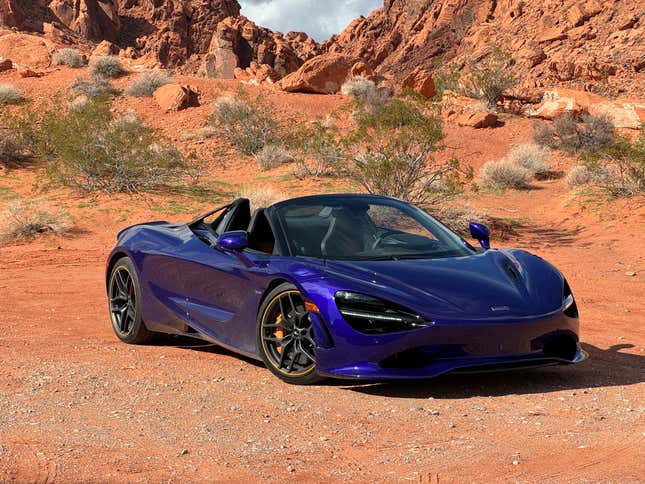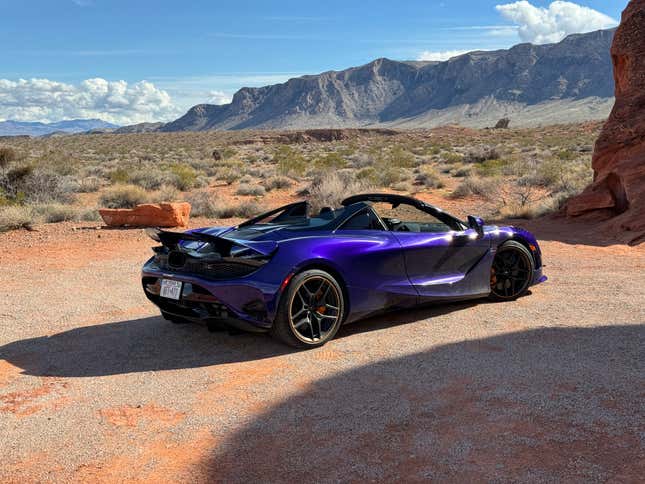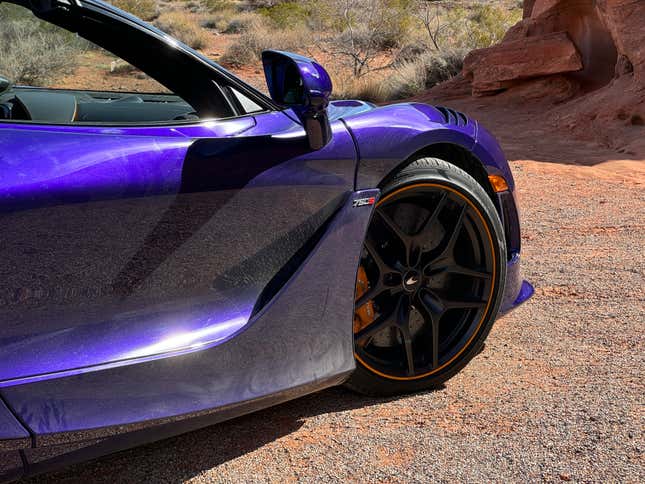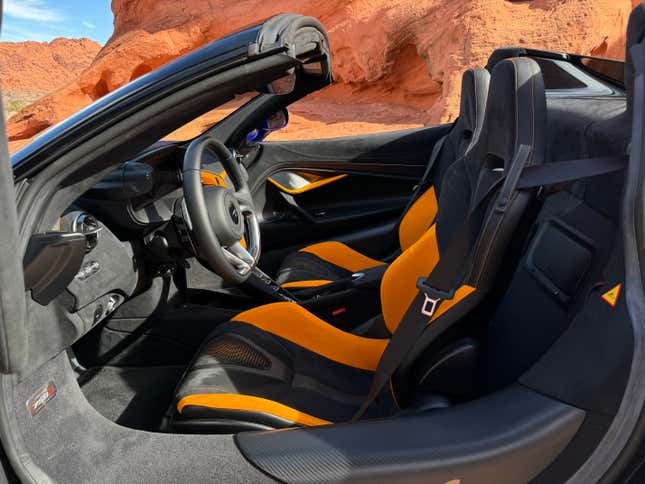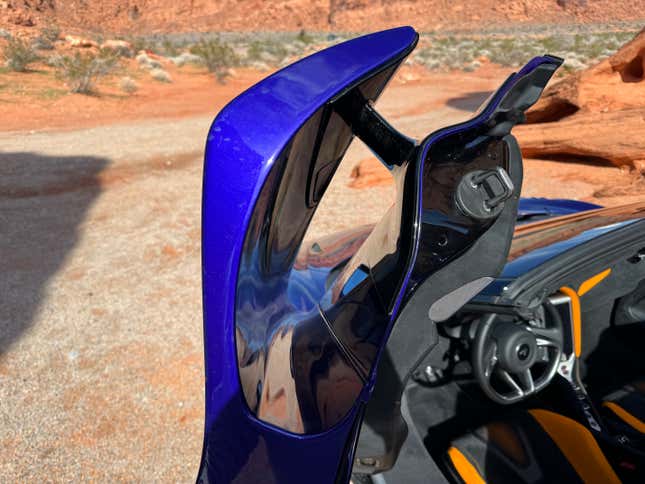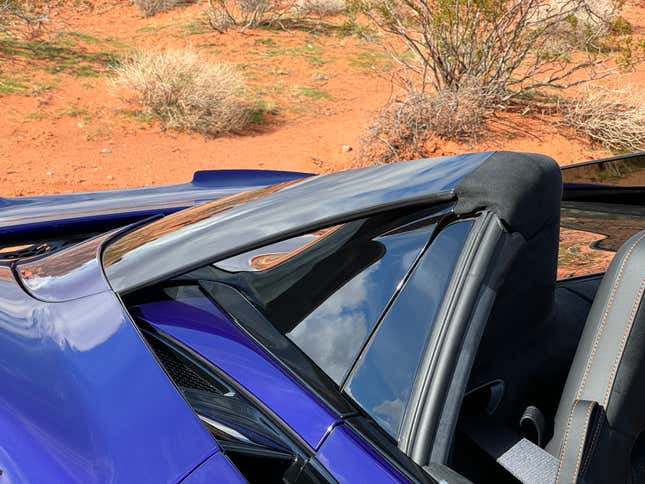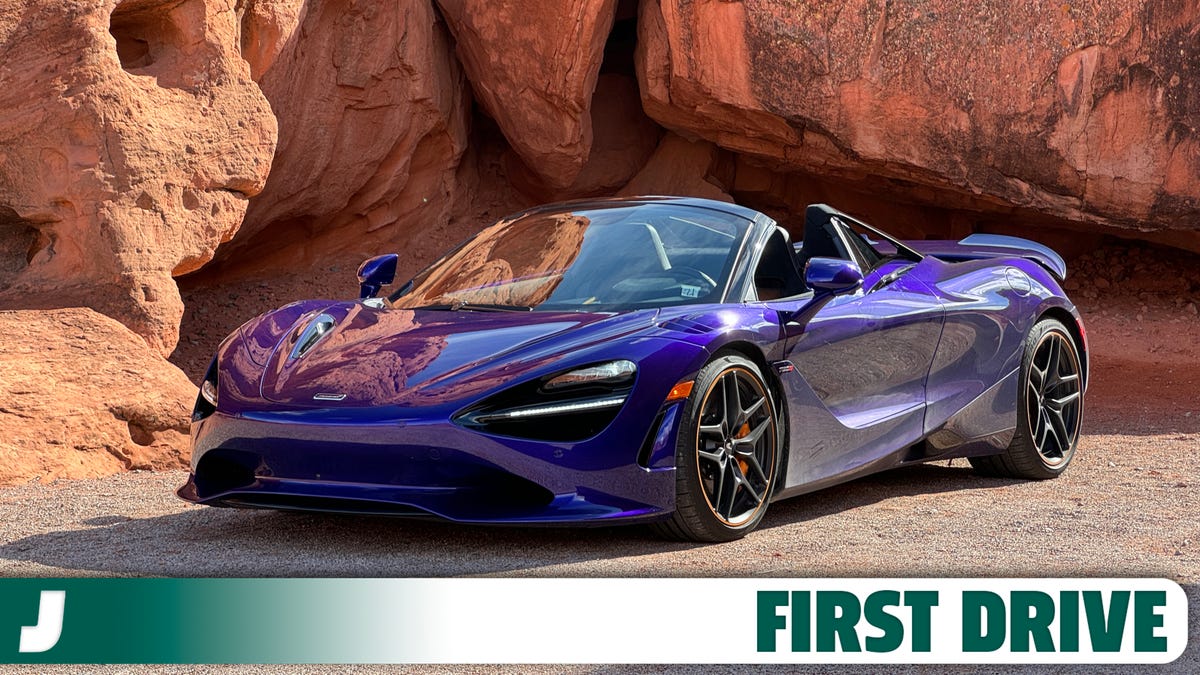I’m standing on the tarmac at Las Vegas Motor Speedway, getting ready to drive through the desert in a convoy of new McLaren 750S Spiders with a group of other auto journalists, but instead of looking at the brightly colored supercars and getting excited, we’re all staring at the sky, fist-pumping and shouting “hell yeah!” The Speedway is next to Nellis Air Force Base, and not only are F-22s doing flybys overhead all day, it seems like the pilots are showing off and teasing us a little bit, as if to say, “aww, you guys think you’re going fast today?”
Though as a McLaren spokesperson at the event points out, it was probably the fighter pilots who were jealous of us, and he’s not wrong. It is a pretty good day after all — after I drive a 750S Spider through the spectacular Valley of Fire, I get to then drive a 750S Coupe on said race track. Essentially just a facelift of the 720S using lessons learned from the 765LT, while the 750S isn’t dramatically improved in any specific arena, the sum of its parts (which are 30 percent new) is spectacular. The McLaren 750S is more visceral and engaging, yet even better to live with. It’s the supercar that other supercars dream of being.
Full disclosure: Back in February McLaren flew me to Las Vegas and put me up at the Wynn in a very nice room with a view of the Sphere so I could drive a 750S Spider through the Valley of Fire and a 750S Coupe on track at Las Vegas Motor Speedway. They also took me to one of the best meals I’ve had in a long time at a restaurant that was like a Bioshock level. Thankfully I managed to be on the wave where it didn’t rain on the drive day.
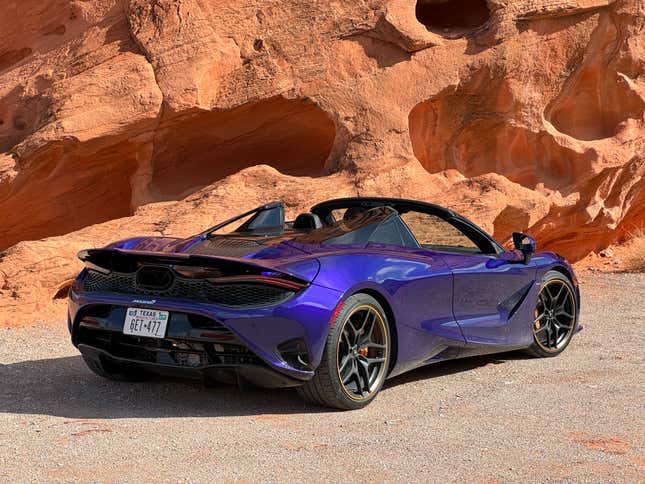
Styling updates are minimal but meaningful. The 750S is obviously an update of the 720S, but the design still makes an impact even amongst newer supercars. The lower bumper ditches the old black/carbon inserts for a more sculpted and integrated design, and the headlight eye sockets are smaller and can be finished in body color, which I think gives the 750S a more alien look. The small intake in the side skirt ahead of the rear wheel arch is redesigned to look like McLaren’s “Speedy Kiwi” logo, there are new intakes at the corners of the rear bumper, and the rear deck’s vents and engine cover have been redesigned. Thankfully, the 750S retains the spectacular air channel air vent along the haunches that allow the car to do without big side intakes.
Instead of the 720S’ dual round pipes, the 750S has a single pill-shaped exhaust tip mounted higher up in the center of the rear end, which is surrounded by a new mesh design for the larger wide vent. McLaren also redesigned the carbon-fiber active rear spoiler, increasing the surface area by 20 percent while reducing weight by 3.5 pounds. A center cutout at the wing’s rear edge avoids it getting blasted by the exhaust’s heat and flames. Of course there are also new wheel designs and tons of colors on offer, and I think that for a car as outrageous as a McLaren, you’ve gotta get one of the bolder shades.
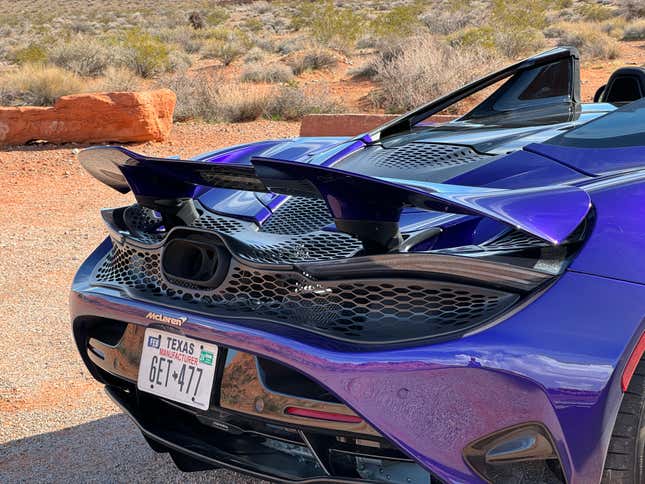
I knew ahead of arriving at the track on our drive day that there was at least one purple 750S Spider available for the drive, so I asked for it ahead of time — it turns out there were three, and I luckily get the best one, with orange-lipped wheels and lots of orange interior accents. Thankfully, this 750S has the comfiest of the car’s three different seat options; the standard buckets definitely provide more support but aren’t as adjustable, while the expensive Senna seats are a no-go for road driving in my book. The butterfly doors and relatively low sill make it a cinch for me to climb in and out, and I’m quick to get into an ideal driving position.
Don’t let anyone tell you that all turbo’d V8s feel the same, because the motor in the 750S is a singular experience. It still uses McLaren’s twin-turbo 4.0-liter V8 engine and 7-speed dual-clutch automatic transmission, with power sent to the rear wheels exclusively. Upgrades include new software, stronger turbos, lighter pistons, dual fuel pumps and a triple layer head gasket (the previous model has two layers). The 750S now makes 740 horsepower and 590 pound-feet of torque, increases of 30 HP and 22 lb-ft over the 720S and only 25 HP off from the 765LT, and redline is a heady 8,500 rpm.
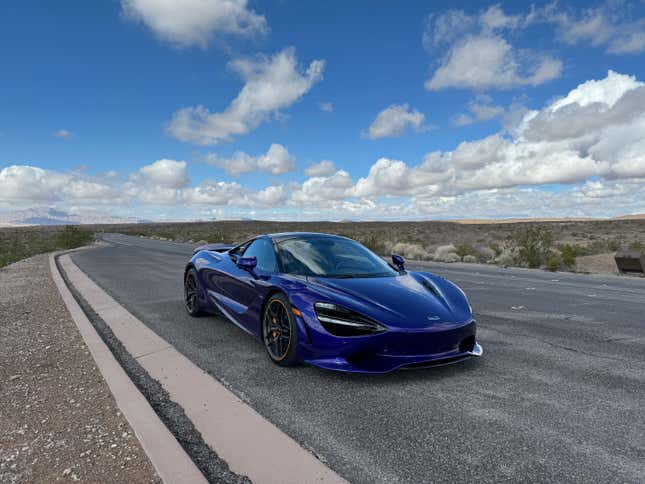
Even driving in Comfort mode on city streets on the way out of Vegas, it’s obvious just how fast this thing is. The lovely gas pedal is sensitive but easy to modulate; it’s not that it’s hard to drive slowly, it just encourages you not to. Give it a slight roll of the ankle and the engine erupts with power alongside rapid downshifts of the transmission. It’s like a cat that always wants its belly rubbed, but will usually immediately attack you for doing so. Using the rocker switches around the gauge cluster to switch engine and handling modes to Sport prompts an instant change in the 750S’ character, like when said cat spots a squirrel and gets the zoomies.
Acceleration is absolutely ferocious, with McLaren claiming a 0-to-60-mph time of 2.7 seconds, but having driven much quicker EVs that bit’s not really impressive — what is impressive is the 0-to-124-mph time of 7.2 seconds. That means the 750S is a tenth quicker to 60 and more than half a second quicker to 124 than the 720S, and the 750S matches the 765LT to 60 and is only two tenths off to 124 mph. (The Spider is a tenth slower than the Coupe in both metrics.) The 750S’ final gear is shorter, so top speed has dropped from 212 mph to 206 mph, but it leads to 10-percent faster in-gear acceleration. Luckily braking performance is improved as well, with the 750S requiring 371 feet to stop from 124 mph and just 98 feet to stop from 60 mph, and the optional carbon-ceramics have fantastic pedal feel and have linear action at all speeds.
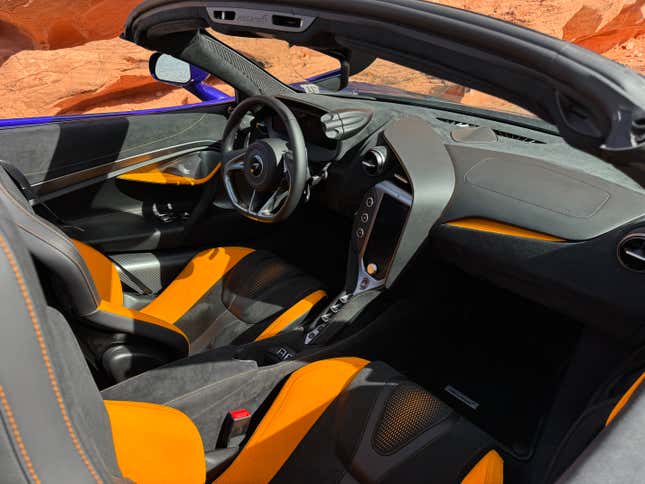
At its lightest, the 750S weighs just 2,815 pounds, a decrease of 66 lbs from the 720S and lighter than all of the competition — hell, it’s more than 300 pounds lighter than a new Porsche 911 GT3. The 750S’ new, 4.4-pound-lighter hydraulic suspension setup is 3 percent softer up front and 4 percent stiffer in the rear, and McLaren has tuned it for improved comfort and balance, reduced body roll and greater feedback. McLaren is blissfully still using an electrohydraulic steering rack, which in the 750S has a quicker ratio and new power pump for faster responses and better feel, resulting in what must be the greatest steering of any car on sale.
I’m so sorry to say it, but driving the 750S on the fabulous two-lane roads that snake around Lake Mead and through the Valley of Fire, I feel like a frickin’ fighter pilot. Driving the 750S quickly is intense and requires mega concentration, but it’s also mega rewarding. The way it gains speed is intoxicating, and the shorter gearing means that I’m able to bang through more of the gears between the road’s many bends. The nicely weighted steering combines with the updated chassis to give the 750S handling that’s composed yet still playful, almost telepathically connected to driver inputs, and I never have the desire to put the car in Track mode or dial back the driver aids on the street. The 750S is just a true joy to drive.
And my god, does it sound good. That new exhaust is 4.8 pounds lighter than the 720S’, and McLaren says it was tuned “to give a sharp crescendo and a distinctive full, natural and clear tone.” The variety of sounds emitted by the V8 are what really get me; it barks and shouts, growls and screams, wails and whispers. Every section of the rev range results in different noises, and McLaren also tuned the engine and transmission for the strongest shifts and most reactive noises in the mid-range, where most of the driving is done. Both downshifts and upshifts produce nice burbles and bangs from the exhaust, none of which sound artificial or pre-programmed. And even at the engine’s loudest, I still can hear the turbos flutter and whistle.

I’m not usually a convertible guy, but the Spider’s retractable rear window and $9,100 electrochromic glass roof panel would make me take it over the Coupe. That rear window is perfectly shaped to let tons of exhaust noises into the cabin without adding any buffeting or letting other noises in, even on the freeway. With the top down, which is accomplished in just 11 seconds at speeds of up to 31 mph, the cabin is still a nice place to be even at high speed. The Spider looks better than the Coupe too, though it loses the option of having an illuminated visible engine bay like the Coupe, and the Spider is just as stiff as the Coupe and only weighs 108 pounds more.
When I’m not acting out my Maverick fantasy, the 750S is shockingly easy to live with. Aside from the high beltline, visibility is impressive, and the transparent flying buttress C-pillars are still a stunning and useful detail. There’s not too much road, wind or tire noise entering the cabin, and even after hours in the car I don’t feel sore or cramped. At the very end of the road loop before jumping on the highway to head back to the track, we drive down a super long, straight road made up of very rough pavement with lots of big dips and crests. I feel every little imperfection in the road through my rear end and my fingertips, and I have to constantly make little steering adjustments to keep the car pointed straight. That might sound tiring, and it is a bit, but it reminded me of dailying my old NA Miata in that it makes every journey an engaging one.

What’s still not great to live with is the 750S’ in-car technology. It has a new vertically oriented touchscreen that has updated graphics and can now run wired Apple CarPlay, but the system is still pretty slow and clunky to use overall, and the screen is prone to glare especially with the top down. The lack of buttons on the lovely steering wheel might be great for the purist driver, but it means a lot of functions are relegated to stalks and buttons that can be annoying to use. The $4,000 surround-view camera system shows a top-down view on the center screen and the backup camera view in the gauge cluster, which is nice, but image quality is pretty bad, especially for the birds-eye view. There’s also a distinct lack of cabin storage space, and the only cupholder is basically unusable. I will say the $5,400 12-speaker Bowers & Wilkins sound system is great, though.
It’s a good thing the 750S is so relaxing to drive normally, because after a calming stint on the freeway where truly everyone else on the road gives me a thumbs up or snaps a photo of the purple supercar, I arrive back at the Speedway to get ready to drive on the track — but not before getting a ridealong in the intense Artura Trophy. For the track portion of the day we swap into 750S Coupes, and I get a car with the optional Senna carbon-fiber bucket seats and rear rollbar. Sitting shotgun are instructors from the Dream Racing school that uses the track, who do a great job of encouraging us to quickly improve.
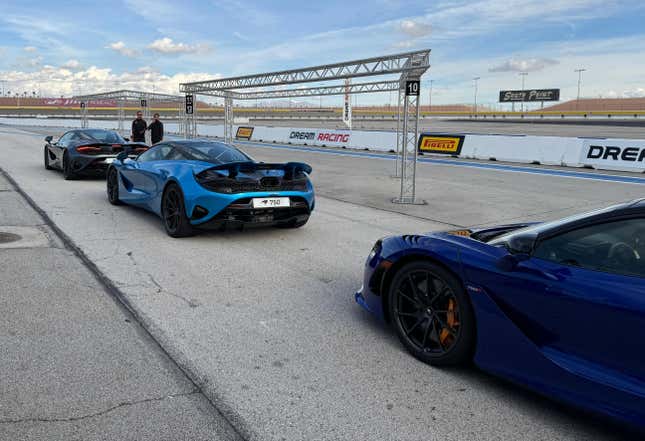
The Speedway’s 1.2-mile road course is totally flat and has 9 corners with high curbs but lots of runoff. In Track mode and wearing the optional Pirelli Trofeo R tires, the 750S has a seemingly endless amount of grip and perfect balance, with perfect turn-in and tons of responsiveness from the steering and chassis. A lot of the turns are pretty tight and come in quick succession, but the 750S is fast enough to carry a ton of speed through the corners and reach well into triple digits on the main straight. This Coupe has the optional $18,050 Track Brake Upgrade, and the effect of the carbon stoppers combined with the rear spoiler’s instant air brake mode gives the 750S some of the most powerful slow-down power I’ve ever experienced — especially once my instructor convinces me to really fully stomp on the pedal — with the car only giving me the slightest wiggle under deceleration before I quickly tossed it into the next corner. In manual mode the 750S will hold the engine at redline when braking and downshifting manually, so the car is ready to rocket ahead upon exiting the turn.
I’m able to do two sessions of about half a dozen laps each. On every subsequent lap my instructor tells me to accelerate sooner and harder, to turn in sharper and to brake later, to be more confident overall. The more I drive the 750S the better it gets and the more confident I feel — after I spin out in one corner after using too much of a curb with the stability control dialed back a bit, I get right back into the groove and start going even quicker on the next lap. At the end of the afternoon I’m mentally and physically a bit exhausted, but if they told me I could have kept going for hours longer, I would.
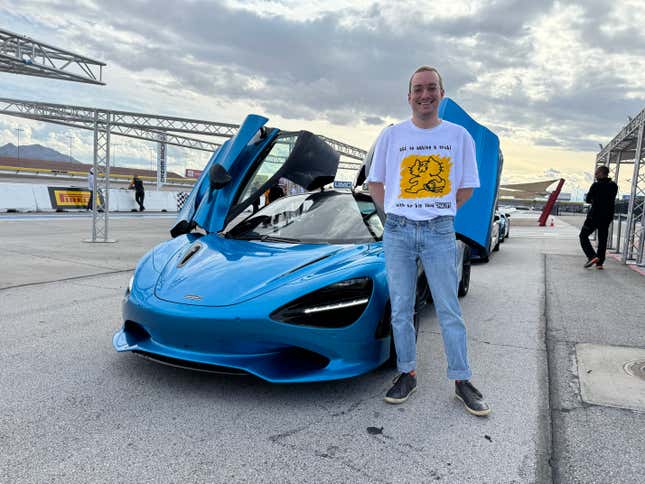
At $423,340 all-in my purple 750S Spider is actually one of the cheapest cars at the launch event, as it doesn’t have any of the optional visible carbon-fiber accents, bucket seats or other items that drive up the price — one Spider costs a whopping $502,550. Don’t take that to mean this car isn’t loaded-up though, as it has more than $70,000 in options. These range from the $9,900 paint and $5,900 wheels with $1,700 titanium wheel bolts to the $8,750 painted carbon-fiber front fenders and $3,300 carbon door sill trim. Even before you start adding on the add-ons, the 750S is still quite expensive albeit in line with competitors like the Ferrari 296. The Spider’s starting price of $351,800 (including $5,500 destination and $1,300 gas-guzzler tax) is worth the extra ask over the $330,800 Coupe, I think.
Is that an absurd amount of money? Sure. Does that matter to the people who are buying these things? Definitely not. In fact, McLaren says that the 750S is sold out at least through spring 2025, with more than 50 percent of the allocations already spoken for. On hundred percent of 750S production will be custom-ordered cars, and out of the initial orders, 75 percent of customers have gone for McLaren Special Operations content to further personalize their cars.
Potential McLaren reliability concerns aside, which the brand is addressing with improved warranty offerings, I can’t imagine those customers will be disappointed with their purchases. The new 750S is the supercar benchmark, as engaging to drive on the road as it is on the race track, and it’s now better to use as a normal car to boot. Now I just need to figure out what my callsign would be.
